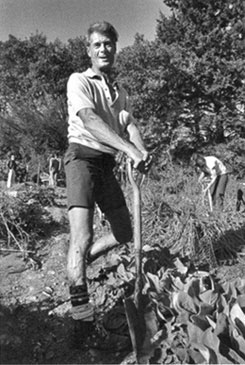I MET MY TAPROOT garden teacher, Alan Chadwick, twenty-six years ago at the end of his life. He had less than six months to live and he knew it. He was a gaunt, kingly man, seventy-one years old and impossibly handsome. A mixture of Old Testament prophet and renegade monk in the tradition of Ikkyu, Alan inhabited the still-fiery body and mind of an aristocratic mad English gardener and a Shakespearean actor. Although prostate cancer was ravaging his body, Alan had come home to Green Gulch not to die but to live out and teach his remaining days.
I was a young Zen student then, unburdened by notions of lineage or entitlement. From the moment I saw Alan surveying the December garden in the last light of the low winter solstice sun, he was for me an authentic Zen teacher, made up of non-Zen elements. The garden was his field of practice, far beyond form and emptiness. Alan was not a domesticated being. He turned to meet me that day with a mixture of hauteur and disdain and announced in a pale, imperious voice, “I intend to be in the garden tomorrow.”
Alan never made it to the garden. Instead, those of us who lived and worked with him brought the garden to him, in bowls of ripe, woodsy compost and immodest bouquets. Rumored to have been tutored by Rudolf Steiner as a child and trained in a precursor to the National Theatre of England as well as in the best gardens and horticultural schools of Old Europe, Alan had uncompromising expectations of his students. In 1967, at the age of fifty-eight, he was summoned from abroad to Santa Cruz, California, to create a garden on the newest University of California campus. Surveying the thickets of blackberry and poison oak that covered the hills at the campus gate, Alan grabbed his spade and began immediately to eke paradise out of the steep flanks of those pestiferous hills. Alan gardened that spot from sunrise to dark, seven days a week, at first alone, but eventually alongside young students who understood fully that working in the garden with Alan was their true education.

By the second growing season of its existence, the UCSC garden covered four acres of wild hillside. Nothing about this garden—with its lush beds of cottage roses and fragrant sweet peas, its young apple trees underplanted with plump butter lettuce and dark drifts of spinach, growing next to hundred-foot-long lines of Marmande tomatoes pushing up through lime green and opal basil—was tame. “You enter the garden because you love creation,” Alan taught dramatically in 1972. “You will gradually bring about a lush ecology that magnifies in intensity with every season. In this spark there is going to be a fire of orchards, vegetables, flowers, and magnificent plants of every kind. This in turn will bring about an ecological fire in people . . . and effect the happiness of living.”
And so it was. By the time I met Alan at Green Gulch in 1980—long before organic gardening or West Coast Zen was in vogue—he had taught and influenced thousands of students worldwide. In outspoken response to the materialism of the industrial growth society, Alan helped to spawn at least ten magnificent biointensive teaching and production gardens that continue to thrive today. The Green Gulch garden is one of these gardens. He died there on May 25, 1980, and we buried Alan’s ashes in the rocky hillside above the garden.
It was never easy to practice with Alan. He railed against the laziness and discouragement of modernity and vague spirituality, while offering a teaching that was passionate, precise, and mercurial. He granted and took away with the same hand. I learned the fundamentals of horticulture from Alan Chadwick: cultivation of the garden and of the gardener, fertilization of the living ground from death itself, propagation of towering foxgloves from a pinch of dust-sized seed, and how to tend the garden in a nonrepeating universe.
“Verbosity, verbosity!” I can hear my teacher rant, gesturing with his long, bony finger to get back to the garden that grows at the edge of the world, made up always of non-garden elements.
Thank you for subscribing to Tricycle! As a nonprofit, we depend on readers like you to keep Buddhist teachings and practices widely available.